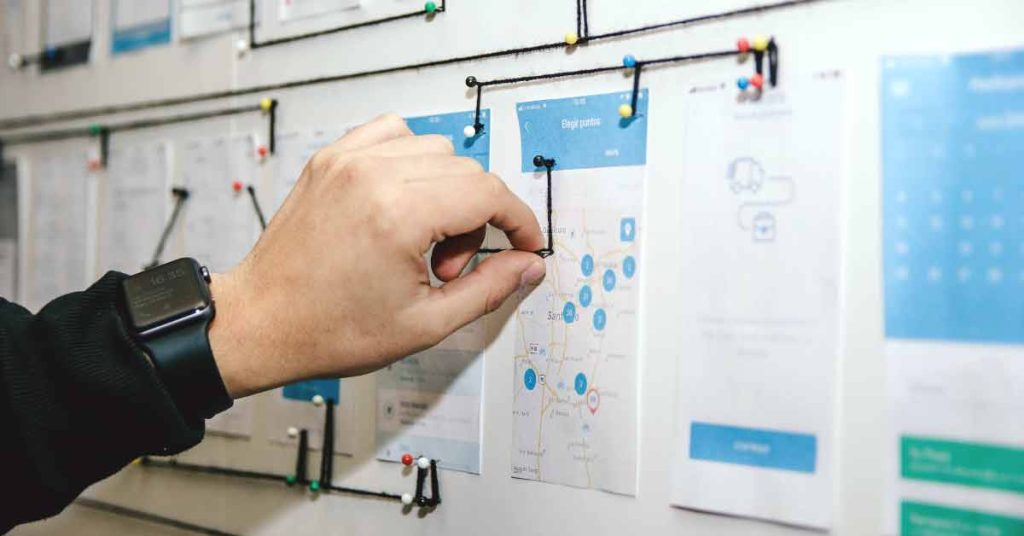If you’re want to create delightful digital experiences for your customers, you’ve come to the right place. In this article, we’ll embark on an exciting journey into the world of User Experience Design, often referred to as UX design. Together, we’ll unravel the mysteries of UX design, understand its significance, and explore the tools and principles that can elevate your designs. So, grab your favourite beverage, sit back, and let’s dive into the fascinating universe of UX design.
Table of Contents
What is User Experience (UX)?
Before we plunge into the depths of UX design, let’s start with the basics. What exactly is User Experience (UX)? At its core, UX encompasses the overall feeling a user has while interacting with a digital product or service, like a website. It’s like the ambiance of a restaurant; it sets the mood for the entire dining experience.
Imagine you’re in a cosy, well-lit bistro with a friendly staff, soothing music, and delectable dishes. This delightful combination creates a memorable dining experience, making you want to return. In the digital realm, UX is similar; it’s about crafting an enjoyable and intuitive journey for users while they navigate your website or application.
UX is about crafting an enjoyable and intuitive journey for users
A well-crafted UX design ensures that users can effortlessly find what they need, complete tasks efficiently, and leave with a positive impression. It’s the difference between a frustrated user and a delighted one, and it’s a crucial aspect of web design that can make or break your online presence.
Why is UX important? The Value of UX Design
Now that we’ve defined UX, you might be wondering, “Why does it matter so much?” Well, the value of UX design is immense, and here’s why:
Boosts User Satisfaction
Imagine a website where everything is neatly organised, buttons are intuitive, and pages load swiftly. Users are more likely to stay engaged, explore, and return for more. On the other hand, a confusing, sluggish site is likely to frustrate visitors, sending them straight to your competitors. A well-crafted UX design ensures user satisfaction and loyalty.
Increases Conversion Rates
Whether you’re running an e-commerce site or a blog, conversions are key. UX design can significantly impact conversion rates. According to a recent industry report, websites with an optimized UX design experience a 400% increase in conversion rates. When users have a seamless and enjoyable experience, they’re more likely to take the desired actions, such as making a purchase, signing up for a newsletter, or filling out a contact form.
Reduces Bounce Rates
A high bounce rate, where users leave your site shortly after arriving, is a red flag. It signals that something isn’t right with your UX. A study found that 38% of users will stop engaging with a website based on its design. With a user-centred approach, you can reduce bounce rates by providing visitors with what they came for and keeping them engaged.
Enhances Brand Reputation
A website with excellent UX becomes a powerful brand ambassador. Users associate their positive experience with your brand, which can lead to positive word-of-mouth recommendations and a solid online reputation.
Incorporating MCloud9’s web hosting services into your UX design can further enhance these benefits. Fast-loading pages, secure hosting, and reliable uptime contribute to a seamless user experience. It’s like having the perfect location for your restaurant, ensuring your customers have a great time.
The Role of a UX Designer
Now that you understand the importance of UX design, let’s delve into the role of a UX designer. Think of them as the master chefs in our restaurant analogy. UX designers are responsible for creating the entire dining experience, from the menu to the ambiance.

A UX designer wears multiple hats, including researcher, architect, and storyteller. Here are some key responsibilities:
- UX Research: To understand your diners (or users), the UX team conducts thorough research. They gather insights into user behaviour, needs, and pain points.
- Information Architecture: UX designers structure the content and layout of your website or app, ensuring that everything is organised logically and intuitively, this is a pivotal part of the design process.
- Wireframing and Prototyping: Before the final design, designers work on the visual design by creating wireframes and prototypes to demonstrate the user journey and interactions.
- Usability Testing: Testing is crucial to identify and rectify issues in the interaction design. UX designers conduct usability tests to gather user feedback and make improvements.
- Collaboration: They work closely with UI designers, developers, and stakeholders to bring the design to life, ensuring that it aligns with the overall vision.
Key Principles of UX Design
Creating exceptional user experiences requires adhering to certain principles. Let’s explore these fundamental guidelines that should be at the core of every UX designer’s toolkit:
User-Centred Design
The user should always be at the forefront of your design decisions. Consider their needs, preferences, and pain points throughout the design process. UX design involves creating a cohesive experience for the user across all their devices.
Clear Navigation
Your website or app should be as easy to navigate as a well-marked restaurant menu. Users should effortlessly find what they’re looking for.
Consistency
Consistency in design elements, such as buttons, fonts, and colours, creates a cohesive and familiar user experience.
Accessibility
Just as a restaurant should be accessible to all diners, your digital platform should be inclusive and accessible to users with disabilities.
Feedback and Response
Provide feedback to users when they take actions, such as filling out a form or making a purchase. Ensure that the system responds promptly to their inputs.
Minimalism
Simplicity often leads to elegance. Avoid clutter and unnecessary complexity in your design.
Performance Optimisation
A speedy website or app is crucial for user satisfaction. Optimise your design for fast loading times.
Tools for UX Designers
Now that you understand the principles, let’s talk about the tools that can help you craft exceptional user experiences. Remember, having the right tools is like a craftsman having quality materials—essential for success.

Wireframing and Prototyping Tools
Tools like Figma, Sketch, and Adobe XD enable designers to create wireframes and interactive prototypes. With MCloud9’s reliable hosting, you can easily showcase your prototypes to stakeholders or clients.
Usability Testing Tools
Platforms like UsabilityHub and UserTesting.com allow you to gather valuable feedback from real users, helping you refine your designs.
Analytics and User Behavior Tools
Tools like Google Analytics and Hotjar help you understand how users interact with your site, allowing you to make data-driven decisions. MCloud9’s hosting supports integration with these essential tools.
Collaboration and Communication Tools
Effective communication is key in UX design projects. Tools like Slack and Trello facilitate seamless collaboration between team members and clients.
The Difference Between UI and UX
Before we wrap up our journey into the world of UX design, it’s essential to address a common misconception: the difference between User Interface (UI) and UX design. It’s like distinguishing between the interior design of a restaurant and the overall dining experience.
UI design focuses on the visual elements users interact with, such as buttons, icons, and colour schemes. It’s about making the interface aesthetically pleasing and user-friendly.
UX design, on the other hand, encompasses the entire user journey. It involves user research, information architecture, and usability testing, aiming to create a seamless and enjoyable experience.
In our restaurant analogy, UI design is akin to the decor and table settings, while UX design encompasses everything from the ambiance to the menu choices. Both are essential for a successful dining experience, just as UI and UX design work in tandem to create exceptional digital experiences.
FAQ for UX Design
What is UX design?
User Experience (UX) design is the process of enhancing user satisfaction by improving the usability, accessibility, and pleasure provided in the interaction between users and a product.
What is the difference between UX and UI?
UX (user experience) design focuses on the overall experience a user has with a product, while UI (user interface) design focuses on the visual and interactive elements of a product. UX design is more concerned with how a user feels and interacts with a product, while UI design is more concerned with how a product looks and functions.
How can I become a UX designer?
To become a UX designer, you can start by gaining a solid understanding of design principles and acquiring UX skills such as wireframing, prototyping, and user research. Taking courses or obtaining a degree in UX design can also be beneficial.
What is design thinking?
Design thinking is a problem-solving approach that focuses on understanding the user’s needs and finding innovative solutions. It involves empathy, ideation, prototyping, and testing to arrive at a final design that meets the user’s needs.
What are some essential UX design skills?
Some essential UX design skills include user research, wireframing, prototyping, information architecture, interaction design, and usability testing. UX designers should also have good communication and collaboration skills.
How important is a design portfolio for a UX designer?
A design portfolio is crucial for a UX designer as it showcases their skills, experience, and design thinking process. It provides potential employers or clients with a glimpse of the designer’s capability and helps them make an informed decision.
What is a good UX design?
A good UX design is one that is intuitive, user-friendly, and meets the needs and goals of the users. It should provide a positive and enjoyable experience, with clear navigation and seamless interaction.
In Conclusion
As we conclude our journey through the world of UX design, remember that crafting exceptional user experiences is not just a trend but a necessity in today’s digital landscape. Your website or application is your digital restaurant, and MCloud9’s web hosting services are the foundation that supports your success.
By prioritising user satisfaction, adhering to key UX principles, and utilising the right tools, you can design digital experiences that leave a lasting impression. So, whether you’re a seasoned designer or just starting your journey, keep the user at the centre of your design process, and you’ll create digital masterpieces that rival the finest restaurants in town.
Now, armed with this knowledge, it’s time to roll up your sleeves and start crafting remarkable user experiences. Happy designing!


